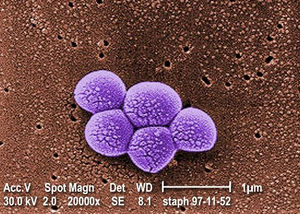Faecalibacterium prausnitzii Relating to Gastroenterology Diseases: Difference between revisions
| Line 2: | Line 2: | ||
[[Image:Mrsa_magn_lg.jpg|thumb|300px|right|Magnified 20,000X, this colorized scanning electron micrograph (SEM) depicts a grouping of methicillin resistant <i>Staphylococcus aureus</i> (MRSA) bacteria. See PHIL 617 for a black and white view of this image. Phoro credit: [http://www.cdc.gov/ CDC.]]] | [[Image:Mrsa_magn_lg.jpg|thumb|300px|right|Magnified 20,000X, this colorized scanning electron micrograph (SEM) depicts a grouping of methicillin resistant <i>Staphylococcus aureus</i> (MRSA) bacteria. See PHIL 617 for a black and white view of this image. Phoro credit: [http://www.cdc.gov/ CDC.]]] | ||
By Kayla Arone <br> | By Kayla Arone <br> | ||
<br | <br>Faecalibacterium prausnitzii<i> is a Gram-negative bacterium, non spore-forming and extremely oxygen sensitive. This type of gut bacteria is the most abundant bacterium in the human gut, accounting for 5-15% of the total bacterial population in the gut. Decreased F.prausnitzii levels are observed in various forms of different inflammatory bowel disease (IBD), Crohn’s disease (CD), ulcerative colitis (UC), and colorectal cancer (CRC). | ||
<br><b>Double brackets:</b> [[ | <br><b>Double brackets:</b> [[ | ||
Revision as of 19:00, 22 February 2024
Introduction

By Kayla Arone
Faecalibacterium prausnitzii is a Gram-negative bacterium, non spore-forming and extremely oxygen sensitive. This type of gut bacteria is the most abundant bacterium in the human gut, accounting for 5-15% of the total bacterial population in the gut. Decreased F.prausnitzii levels are observed in various forms of different inflammatory bowel disease (IBD), Crohn’s disease (CD), ulcerative colitis (UC), and colorectal cancer (CRC).
Double brackets: [[
Filename: PHIL_1181_lores.jpg
Thumbnail status: |thumb|
Pixel size: |300px|
Placement on page: |right|
Legend/credit: Magnified 20,000X, this colorized scanning electron micrograph (SEM) depicts a grouping of methicillin resistant Staphylococcus aureus (MRSA) bacteria. Photo credit: CDC. Every image requires a link to the source.
Closed double brackets: ]]
Other examples:
Italic
Subscript: H2O
Superscript: Fe3+
Sample citations: [1]
[2]
A citation code consists of a hyperlinked reference within "ref" begin and end codes.
To repeat the citation for other statements, the reference needs to have a names: "<ref name=aa>"
The repeated citation works like this, with a forward slash.[1]
Section 1
Include some current research, with at least one figure showing data.
Every point of information REQUIRES CITATION using the citation tool shown above.
Section 2
Include some current research, with at least one figure showing data.
Section 3
Include some current research, with at least one figure showing data.
Section 4
Conclusion
References
Authored for BIOL 238 Microbiology, taught by Joan Slonczewski,at Kenyon College,2024
Section 4
Conclusion
References
Authored for BIOL 238 Microbiology, taught by Joan Slonczewski,at Kenyon College,2024
